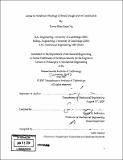| dc.contributor.advisor | Gareth H. McKinley. | en_US |
| dc.contributor.author | Ng, Shen Kuan (Trevor Shen Kuan) | en_US |
| dc.contributor.other | Massachusetts Institute of Technology. Dept. of Mechanical Engineering. | en_US |
| dc.date.accessioned | 2008-09-03T15:13:42Z | |
| dc.date.available | 2008-09-03T15:13:42Z | |
| dc.date.copyright | 2007 | en_US |
| dc.date.issued | 2007 | en_US |
| dc.identifier.uri | http://hdl.handle.net/1721.1/42288 | |
| dc.description | Thesis (Ph. D.)--Massachusetts Institute of Technology, Dept. of Mechanical Engineering, 2007. | en_US |
| dc.description | Includes bibliographical references (p. 263-282). | en_US |
| dc.description.abstract | There are many practical reasons for studying the deformational behavior or rheological properties of a dough system. The mass production of bread has led to a need of machines that are able to handle and process large volumes of dough. An understanding of the deformational properties can aid in designing machines of this kind. Less obviously, the texture of the bread we eat is governed by the mechanical properties of the dough from which it is proofed and baked from. During the bread making process, large non-linear deformations feature prominently. In mixing and kneading, dough is stretched and sheared by hand or by specially designed mixing devices, while in proofing and baking, the expansion of gas cells causes significant extensional strain on the surrounding dough. Other than directly affecting the moduli of the fibers and membranes in the solid phase of bread, a link between the rheology of dough and the baked loaf volume has also been established. In this thesis, we first develop consistent and accurate techniques for measuring the rheological properties of the dough. Good experimental techniques and protocols are essential for studying the mechanical properties of such a sticky, visco-elasto-plastic, time-dependent material. We modify some of the standard rheometric hardware and protocols to accommodate this unusual material. Special attention is given to nonlinear deformations such as uniaxial extensional flows and large amplitude oscillatory shear flows (LAOS). We use the new techniques to probe the microstructure of dough and its constituents from a mechanical viewpoint. The strongly nonlinear rheological properties of dough arise from the interactions of a protein matrix and a high filler concentration consisting of hydrated starch particles. | en_US |
| dc.description.abstract | (cont.) We demonstrate that the gluten protein that imbues the dough with its characteristic viscoelasticity should be considered as a transient network that is interconnected by finitely extensible biopolymer segments (-20nm mesh size) and held together by hydrogen bonds and/or hydrophilic interactions. Using this renewed understanding of the microstructure, we construct appropriately frame-invariant constitutive equations (generalized gel equation and a multi-mode FENE network model) that describe the rheology of gluten gels with a minimal number of parameters. The behavior of gluten gels can then be related to prototypical flour-water doughs by the effects of the starch filler using the concept of strain amplification. Finally, this general framework of microstructure and rheological properties of gluten gels and flour-water dough are applied to practical situations. We discuss the utility of this work in context to some specific case studies of rheological aging, the effects of water content and flour-type variations. | en_US |
| dc.description.statementofresponsibility | by Trevor Shen Kuan Ng. | en_US |
| dc.format.extent | 282 p. | en_US |
| dc.language.iso | eng | en_US |
| dc.publisher | Massachusetts Institute of Technology | en_US |
| dc.rights | M.I.T. theses are protected by
copyright. They may be viewed from this source for any purpose, but
reproduction or distribution in any format is prohibited without written
permission. See provided URL for inquiries about permission. | en_US |
| dc.rights.uri | http://dspace.mit.edu/handle/1721.1/7582 | en_US |
| dc.subject | Mechanical Engineering. | en_US |
| dc.title | Linear to nonlinear rheology of bread dough and its constituents | en_US |
| dc.type | Thesis | en_US |
| dc.description.degree | Ph.D. | en_US |
| dc.contributor.department | Massachusetts Institute of Technology. Department of Mechanical Engineering | |
| dc.identifier.oclc | 232157599 | en_US |
